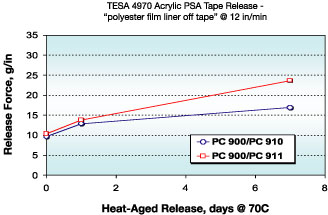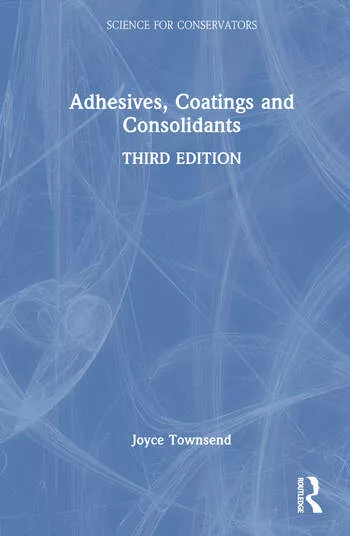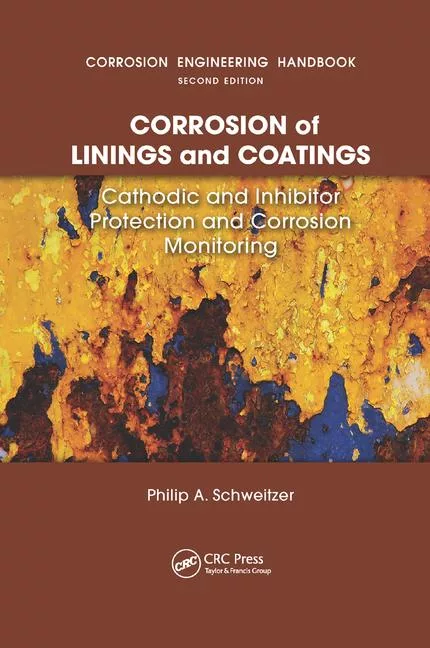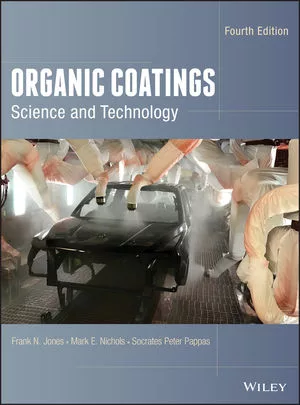UV/EB-Curable Acrylate Silicones for Release Coatings


4 "On Chain" Reactive Groups
4 "Methyl" Siloxane [a] / "Acrylate" Siloxane [b] Ratio = ~10 to 1
4 Chain Length: 1.0 X
- A full range of stable levels and dynamics of release,
- A high-performance adhesion-promoting system,
- A blend-compatible and coatable acrylate-silicone chemistry,
- The potential for an EB-curable "premium" low release, and
- The capability for adding high levels of non-silicone coating extenders.

4 "End Chain" Reactive Groups
4 "Methyl" Siloxane [a] = ~150
4 Chain Length: 1.5 X
UV silicone release coatings are cured by adding 2.0% to 2.5% free-radical photoinitiator. Although there are many potential photoinitiators for these silicones, we prefer those that are oligomeric in nature (oligo = "a few," mers = "units") because "highly flexible" silicones fail to retain many of the "out-gassing," post-UV monomeric photoinitiator by-products. In this study, all coatings were UV-cured with 2.0% ESACURE 100F (70% oligomer and 30% liquid photoinitiator, available from Lamberti USA Inc.)

4 "End Chain / On Chain" Reactive Groups
4 "Methyl" Siloxane [a] / "Acrylate" Siloxane [b] = ~75 to 1
4 Chain Length: 1.5 X
UV-Cure Blends of PC 900 with PC 910, PC 911
Our first analysis formulates blends of PC 900 acrylate silicone with two CRA-minus release modifiers - PC 910 and PC 911 (at 5% to 10% addition). These release coatings were coated onto polyester film at 0.6-0.7 lb/ream [3,000 ft2] and UV-cured @ 400 fpm. They were tested for "accelerated" heat-aged release @ 70 deg C against very aggressive TESA 4970 acrylic PSA tape (Figure 2, page 30).
The test results show that these acrylate-silicone blends are highly release-stable against this very aggressive acrylic PSA tape, even at such high aging temperatures and for such long periods of time. PC 910, with its "end chain" acrylate functionality, its long polymer chain and its high methyl-to-acrylate ratio gives the lowest, most stable release of these two CRA-minus release modifiers.

4 "End Chain / On Chain" Reactive Groups
4 "Methyl" Siloxane [a] / "Acrylate" Siloxane [b] Ratio = ~40 to 1
4 Chain Length: 2.5 X
UV vs. EB Cure: Blends of PC 900 with PC 910, PC 970
Our next analysis formulates blends of PC 900 acrylate silicone with two CRA-minus release modifiers - PC 910 and PC 970 (at 5% to 10% addition). These release coatings were coated onto polyester film at 0.6-0.7 lb/ream [3,000 ft2] and either UV-cured @ 400 fpm or EB-cured @ 400 fpm with a 2-Mrad dose. They were tested for "accelerated" heat-aged release @ 70 deg C against very aggressive TESA 4970 acrylic PSA tape (Figure 3, page 30).
Early research of the effects of EB irradiation on different families of polymers has indicated that most methyl silicone polymers undergo a degree of chain scission ("tearing apart") when exposed to EB bombardment. This chain scission predominates over the "reinforcing" EB-initiated, free-radical crosslinking of these methyl silicones (through the bridging of methyl groups via EB-generated methylene free radicals), so that the overall effect is degradation of the physical properties of the polymer. One plausible explanation for this unique attribute for PC 970 release-modified PC 900 for maintaining very low and easy releases under 2-Mrad EB irradiation results from the PC 970 "on chain" functionality. This "on chain" acrylate functionality along the PC 970 siloxane backbone tends to accentuate the crosslinking of the polymer and thus to predominate over the chain-scission events. The final EB-cured PC 900/PC 970 release coating maintains its high coating integrity, allowing for very low and stable release.

UV-Cure of PC 900/PC 980 CRA-Plus for Tight Release
This analysis formulates blends of PC 900 acrylate silicone with PC 980 CRA-plus release modifier for tight release. Although low and easy "premium" release is the target for most silicone release liners, sometimes it is just as valuable to provide for a certain amount of a more secure and intimate adhesive contact with a silicone-coated surface. This property is sometimes designated as intermediate or tight release.



MFA Extenders
There are times that a silicone release-coating converter may desire to further modify its chemistries for improvements in silicone-polymer blend compatibility, for lowering formulated-bath viscosities to improve silicone-polymer blend coatability/rheology and/or for lowering the overall costs of a silicone release-coating chemistry. We have spent a great deal of time and effort in developing such an extender technology. Our current "best candidate" is based on a proprietary composition of non-silicone components with multifunctional acrylate (MFA) chemistries.Formulations were made up by adding 10% of PC 910, PC 911 and PC 970 CRA-minus release modifiers into PC 900. We added 20% MFA extender to these formulations. These extender-modified release coatings were coated onto 42# SCK paper at 0.9-1.1 lb/ream (3,000 ft2) and UV-cured @ 400 fpm. They were tested for up to 10-days "accelerated" heat-aged release @ 70 deg C against an emulsion acrylic PSA (Figure 5, page 30). The PC 900/PC 970 blend was further heat-aged @ 70 deg C for a full 30 days (Figure 6).
We were encouraged that we could extend our acrylate-silicone release-coating chemistries by as much as 20% and still maintain very desirable low and stable release values. Even more encouraging was the stability of the formulated baths in that there was no sign of any separation of the silicone and extender even after 48 hours. At one month, there was a separation of ~5%, but we found we could easily remix the formulated bath without any detriment to UV-cure response and final release characteristics.
We proceeded to investigate just how far we could extend our acrylate-silicone release coatings. We prepared bath formulations with 0%, 20%, 30% and 40% MFA extender. These release coatings were coated onto polypropylene film at 0.6-0.7 lb/ream (3,000 ft2) and UV-cured @ 400 fpm. They were tested for one-day "accelerated" heat-aged release @ 70 deg C against very aggressive TESA 4970 acrylic PSA tape (Figure 7).
The stability of the formulated baths continued to look encouraging. There was no sign of any separation of the silicone and both 20% and 30% extender, even after 48 hours. At 40% extender, the formulated bath remained stable for 24 hours, but there was a separation of ~5% after 48 hours. Again, we found we could easily remix the formulated bath without any detriment to UV-cure response and final release characteristics.
Conclusion
The PC 900 UV/EB acrylate-silicone polymer can be modified for "premium" low release by blending with one of three release modifiers - PC 910, PC 911 and PC 970. Initial and aged releases are very smooth and stable against a wide variety of adhesive materials. All three CRA-minus release modifiers can be used in UV-cured "premium release" silicone release coatings, while coatings modified with PC 970 exhibit optimized "premium release" properties under EB processing. PC 980 is a modified silicone that provides potent "tight release" coatings. PC 950 is an effective adhesion promoter that also acts as a cure enhancer. Finally, we have developed a very compatible non-silicone MFA extender technology that has been added to acrylate-silicone release coatings at as much as 40% without any apparent sacrifice of UV-cure response or release stability. These coatings are coater-friendly for providing ease of application and consistent coverage onto a targeted paper or film liner.
We have seen how the architectural design of an acrylate-silicone polymer can affect release performance. In particular, we have seen how such polymer attributes as (1) where reactive-acrylate functional groups are located ("end chain," "on chain" and "end chain/on chain"), (2) methyl-to-acrylate siloxane ratios and (3) polymer chain lengths may affect silicone-release performance. Finally, we have seen how different acrylate-silicone polymers may be blended with one another to fine-tune desired release characteristics.
Acknowledgements
The author wishes to recognize the contributions from the global UV/EB release-coatings applications team within the Rhodia organization, especially the extensive contributions from our colleagues Jean-Marc Frances, Veronique Bossenec, Gerard Mignani and Delphine Blanc-Magnard (St. Fons, France); Basil Behnam (Mississauga, Canada); and my colleague Daniel Zufferey (Rock Hill, S.C., U.S.A.). Finally, I want to give special thanks to my onetime colleague Olivier Pinto who provided much of the groundwork on which this report is based.This article is based on a presentation made at RADTECH 2002, Indianapolis. Copyright c 2002, RadTech International N.A., 6935 Wisconsin Ave., Suite 207, Chevy Chase, MD 20185. Reprinted with permission from the RADTECH 2002 Conference Proceedings.
Additional information on UV/EB-curable acrylate silicones is available from Rhodia Inc., PO Box 11674, Rock Hill, SC 29731-1674; call 800-476-5260; fax 803-329-5269; or visit the Web site www.silicones.us.rhodia.com. Or Circle No. 74.
Links
Looking for a reprint of this article?
From high-res PDFs to custom plaques, order your copy today!





